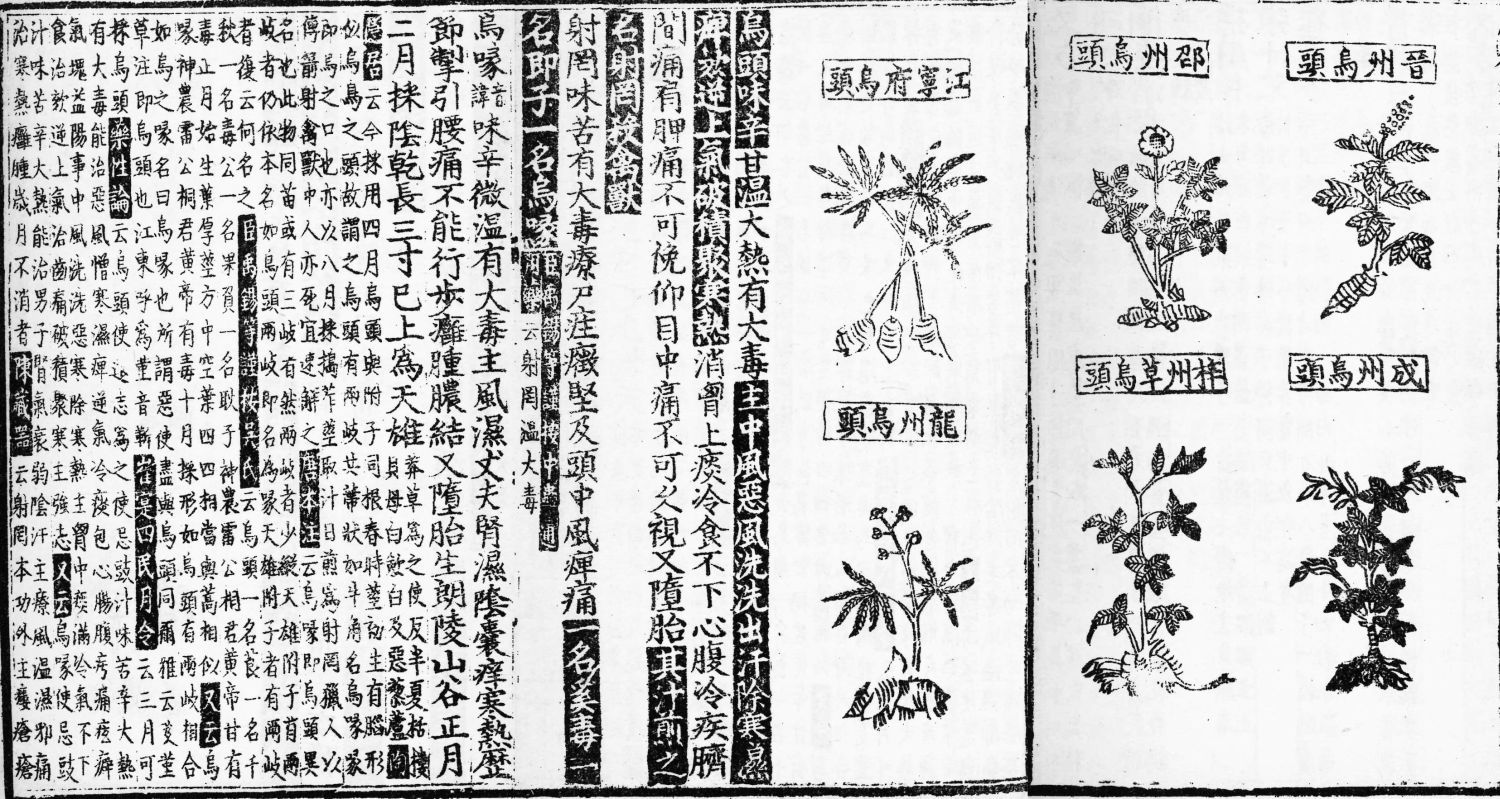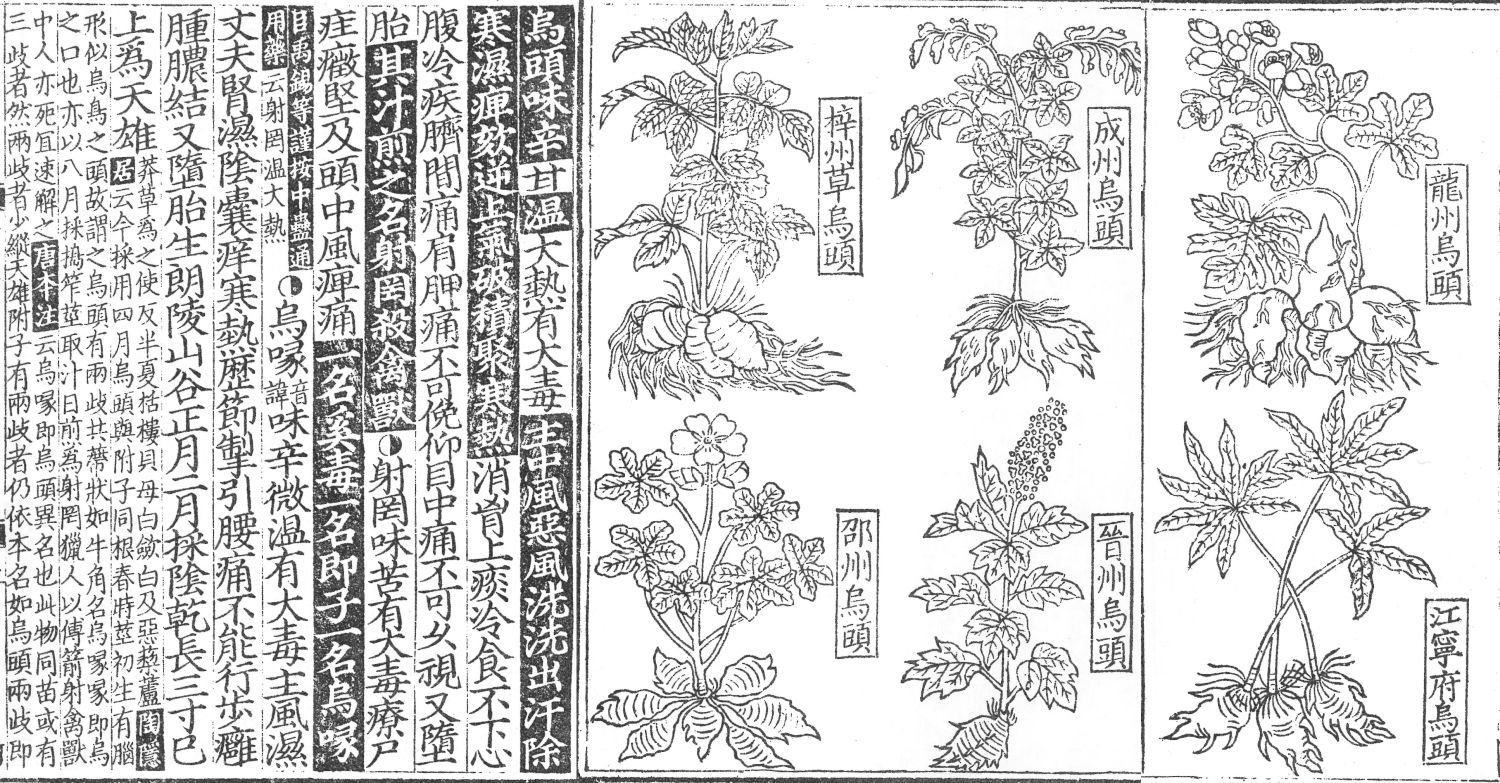Zhenglei bencao 證類本草 "Collected classified materia medica", full name Jingshi zhenglei beiji bencao 經史證類備急本草 "Ready-to-use pharmacopoeia, classified as collected from the Classics and historiographical books", is a book on pharmacology written during the Song period 宋 (960-1279) by Tang Shenwei 唐慎微 (1056-1093), courtesy name Fanyuan 審元. He came from Jinyuan 晉原 (modern Chongqing 崇慶, Sichuan) and hailed from a family of professional physicians. He specialized in pharmaceuticals and preferred his work as a doctor instead of engaging in a career as a state official. As a doctor he began writing down his own experience in clinical medicine, that was enriched by a lot of expertise on drugs he had collected from among the population.
Tang Shenwei screened ancient writings on pharmaceuticals, like the pharmacopoeias Kaibao bencao 開寶本草 (full title Kaibao xin xiangding bencao 開寶新詳定本草 or Kaibao chongding bencao 開寶重訂本草), Jiayou bencao 嘉祐本草 (full title Jiayou buzhu Shen Nong bencao 嘉祐補注神農本草) and the illustrated book Bencao tujing 本草圖經, which is part of the Xinxiu bencao 新修本草. For his own use he joined these two writings into one compendium.
 |
Illustration from a facsimile of a Song-period print of the Zhenghe version of the Zhenglei bencao in the series Sibu congkan 四部叢刊. It shows the different marks of various layers of texts and commentaries to various types of Aconitum (wutou 烏頭). |
 |
The same illustration and text in the imperial series Siku quanshu 四庫全書 from the Qing period, in new standard typesetting. Although the characters are better readable, the clear difference between the textual layers and their commentaries is given up. All the more, the selection of species is less wide. |
 |
Still the same set of plants in a high-quality supplemented edition, Chongxiu Zhenghe jingshi zhenglei beiyong bencao 重修政和經史證類備用本草 (or beiji 備急). |
The book of 30 juan length includes the description of 1,558 different drugs, and a further 476 items that are not included in older texts, coming to a total of 1,748. The text is enriched by 933 illustrations. Some pharmaceuticals are first mentioned in this book, for example, lingsha 靈砂 (a kind of cinnabar, HgS) or the snail Limnaea japoniса (sangniu 桑牛). The category Qinshou 禽獸 "birds and beasts" in the book Xinxiu bencao has been divided into that of Ren 人 "human objects" (for instance, blood, secretes, flesh, hair, excretions of the female menses, clothes), Shou 獸 "beasts", and Qin 禽 "birds". The book is arranged according to the ancient writing Jiayou bencao, whose entries are enriched by statements from the Bencao tujing. The preface includes a history of pharmacological books, a guideline to the compilation of the Zhenglei bencao, and a theoretical part on materia medica.
According to custom, all drugs are classified as of "superior" (shangpin 上品), "mediocre" (zhongpin 中品), and "inferior" (xiapin 下品) quality. Each entry is composed in the following way: The old text of the Shen Nong bencao jing 神農本草經 is written in white characters (in black boxes), that of the Mingyi bielu 名醫別錄 in large black characters. Text quoted from the Xinxiu bencao is marked with the annotation Tang fu 唐附 "Tang-period addition", and text from the Kaibao bencao and the Jiayou bencao are highlighted with the remarks Xin fu 今附 "New addition", and Xin bu 新補 "Recent supplement". As a third layer, Tang Shenwei has added his own comments that are optically separated from the older texts by a horizontal line.
The words bielu 別錄 "Different record" indicate the commentaries to these older texts, namely Tao Hongjing's 陶弘景 (456-536) commentary in his Bencaojing jizhu 本草經集注 (also marked as Tao yinju yun 陶隱居云 "Arcane Master Tao says"), the Tang-period commentary from the Xinxiu bencao (marked as Tangben zhu 唐本注 "Commentary from the Tang version"), the commentary of the Kaibao bencao (marked as Jin zhu 今注 "New commentary"), and that of the Jiayou bencao (marked by the words Chen Yuxi deng jin an 臣禹錫等謹按 "Your servants Yuxi etc. respectfully note", in small white characters).
The Zhenglei bencao quotes from more than 240 ancient writings, a lot of which are very rare, like Chen Cangqi's 陳藏器 (c. 687—757) Bencao shiyi 本草拾遺, Lei Xue's 雷斅 (5th cent.) Leigong paozhi lun 雷公炮炙論, Meng Shen's 孟詵 (621-713) Shiliao bencao 食療本草, or Li Xun's 李珣 (855-930) Haiyao bencao 海藥本草. Some other medical texts are long since lost, like the writings Xiaopinfang 小品方, Fanwangfang 范汪方, Yujifang 玉亟方, Shenshifang 深師方, Gujing luyan fang 古今錄驗方, Cuishi fang 崔氏方, Bixiaofang 必效方, Bingbu shouji fang 兵部手集方, Meishifang 梅師方, Danfang jingyuan 丹房鏡源, Gujin luyan yangsheng biyong fang 古今錄驗養生必用方, Doumenfang 鬥門方, or Shengjinfang 勝金方. The only books that provide similarly rare sources are the Waitai miyao 外臺秘要 or the Qianjinfang 千金方.
Tang Shenwei describes more than 4,000 various treating methods. He explains the particular use of various material media, their function in the theoretical framework of Chinese medicine, the places or origin, collection and preparation methods. For a lot of pharmaceuticals illustrations are added that make it easier to identify individual drugs. The Zhenglei bencao does not only rely on written sources, but also on information from among the people. It clearly shows the high level of pharmaceutical knowledge during the Song period. Although overshadowed by the Ming-period 明 (1368-1644) compendium Bencao gangmu 本草綱目 in significance, the Zhenglei bencao is one of the most important books on drugs in ancient China. It even served as a kind of blueprint for Li Shizhen's 李時珍 (1518-1593) famous Bencao gangmu. Juan 30 includes original text and illustrations of 98 drugs of the Jiayou bencao, as well as 194 drugs mentioned in the ancient texts Shen Nong bencao and Mingyi biezhuan whose identity can not be approved with certainty, or whose medical effects can not be proved (you ming wei yong 有名未用 "have a name [as a drug] but were never used [in practice]").
There existed two different editions of the Zhenglei bencao during the Song period, one with a length of 30 juan, and one with 32 juan length. In 1108 Ai Cheng 艾晟 revised the book. This revision is known under the title of Daguan bencao 大觀本草 "Pharmacopoeia of the Daguan reign-period" (short for Daguan jingshi zhenglei beiji bencao 大觀經史證類備急本草, occasionally also called Daquan bencao 大全本草). It is 32-juan long and covers pharmaceuticals to be found in the whole empire. Ai Cheng's commentaries are signified with the words bie shuo 別説 "Separate explanation". This edition was a state-sponsored edition, unlike Tang's original book, which was a private project. A second state-sponsored revision was realized by Cao Xiaozhong 曹孝忠 (early 12th cent.), who was Supervisor of the Medical School (tiju yixue 提舉醫學). This version is called Zhenghe bencao 政和本草 "Pharmacopoeia of the Zhenghe reign-period" (short for Zhenghe xinxiu jingshi zhenglei beiyong bencao 政和新修經史證類備用本草). A third revision was created under the guidance of Wang Jixian 王繼先 (1098—1181) and published with the title Shaoxing jiaoding jignshi zhenglei beiji bencao 紹興校訂經史證類備急本草). Wang's commentaries are mostly phonetical (yinshi 音釋) and therefore were only of a marginal importance for physicians. It was lost in China and is only preserved in fragments in Japan.
In the Jin empire 金 (1115-1234), Zhang Cunhui 張存惠 (fl. 1249) incorporated the text of Kou Zongshi's 寇宗奭 (fl. 1077) Bencao yanyi 本草衍義 in the text of the Zhenglei bencao and in 1189 published it as a 30-juan long text with the title Chongxiu zhenghe jingshi zhenglei beiyong bencao 重修政和經史證類備用本草. This was the most widespread version of the Zhenglei bencao which was also used for the imperial series Siku quanshu 四庫全書. The Daguan and the Zhenghe versions show only minor differences in the text, but the preface and the illustrations differ in many places. The Zhenghe bencao is also included in the series Wuchang yixueguan congshu 武昌醫學館叢書 and the Sibu congkan 四部叢刊.
Some fragments of Zhang Cunhui's original print (Jin version) are surviving, to be found in the Beijing Library 北京圖書館, and in the Library of Congress in Washington. Both libraries also own prints from the Ming period. The Daguan bencao (Ai Cheng) was published as a facsimile by Ke Fengshi 柯逢時 (1845-1912) in 1904. In Japan, in 1933, the Junyōdō Hall 春陽堂 published a facsimile of some fragments of the Shaoxing version (Wang Jixian). In 1957 the Renmin Weisheng Press 人民衛生出版社 published a modern edition of the Zhenglei bencao, based on the Zhenghe version. This edition also includes a commentary to pharmaceutical books, namely Kou Zongshi's Bencao yanyi from the Song period.
| 1.-2. | 序例 | Preface and introduction |
| 3.-5. | 玉石部 | Jades and other stones |
| 6.-11. | 草部 | Herbs |
| 12.-14. | 木部 | Trees |
| 15. | 人部 | Human body |
| 16.-18. | 獸部 | Beasts |
| 19. | 禽部 | Birds |
| 20.-22. | 蟲魚部 | Scaly and aquatic animals |
| 23. | 果部 | Fruits |
| 24.-26. | 米榖部 | Grains |
| 29.-29. | 菜部 | Vegetables |
| 30. | 本草圖經本經外草類 | Illustrations of herbs not included in the Bencao tujing |
| 本草圖經本經外木蔓類 | Illustrations of trees and creeping herbs not included in the Bencao tujing | |
| 有名未用 | Drugs not yet investigated |